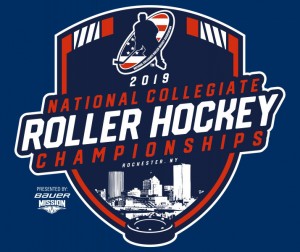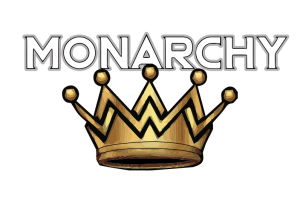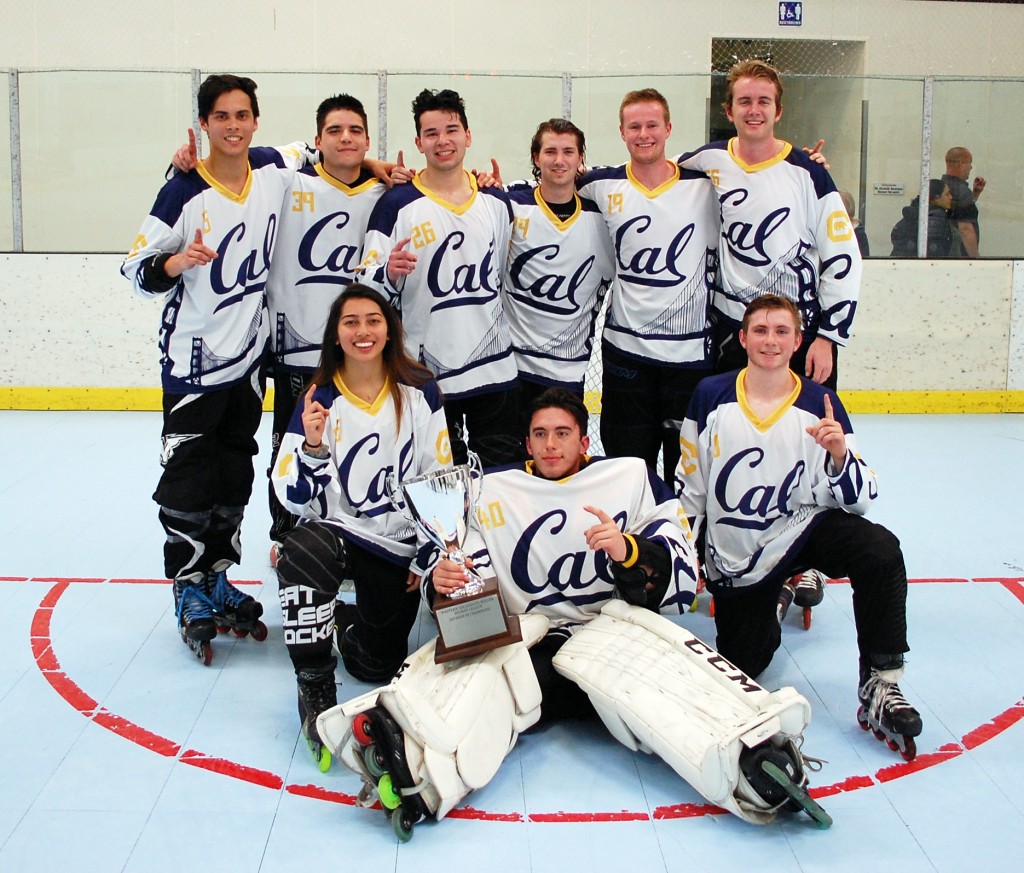Inline nationals to receive brotherly assist with Leone standouts

John and Michael Leone gave their mother Dorothy a photo opportunity to cherish after each helped guide their respective teams to a divisional championship at March’s Western Collegiate Roller Hockey League (WCRHL) regional championship tournament at The Rinks-Corona Inline.
Michael, who is older by two years, earned MVP honors in leading the University of California-Berkeley Golden Bears to the Division III championship following a 6-2 finals win over the regular-season champion Cal Poly Pomona Broncos.
John helped the Cal Poly San Luis Obispo Mustangs capture the Division II championship following a 7-1 finals victory against Cal State University-Fullerton Titans.
After the tournament, the brothers posed for a photo with their mother, with each son holding the championship trophy. It’s a photograph that will surely inspire memories in the Leone household for years to come.
Ironically, the brothers each won WCRHL regional titles as their teams battled it out on adjacent rinks.
“It was a really cool experience winning the championship at the same time as my brother,” Michael Leone said. “I remember I kept looking over at their game during ours thinking ‘Wow, they’re actually winning by a good amount’ when my game was actually kind of close.
“I heard Fullerton was pretty good, so I wasn’t expecting them to pull off a decisive win. But it was cool to finally win something my last year of competitive hockey. Also it was nice for my mom to be there to see that.”
The Golden Bears and Mustangs will next compete at the National Collegiate Roller Hockey Association (NCRHA) national championship tournament April 10-14 at Bill Gray’s Regional Iceplex in Rochester, N.Y.
More photo opportunities could await.
Surf’s up
The Leone brothers hail from San Diego and it’s not too difficult to chart their progress through youth and high school hockey, both ice and inline.
“We both grew up playing ice hockey with the San Diego Jr. Gulls,” John Leone explained. “We played roller hockey together in high school for our team at Cathedral Catholic High School coached by Luke Storno.
“We are San Diego natives. We are both are into surfing and the whole beach lifestyle. Our dad is from Minnesota and he grew up playing pond hockey; so we picked it up when we were little and it’s been the only sport for the most part that we played growing up.”
During his junior year in high school Michael Leone played for the San Diego Gulls Junior A team (now San Diego Sabers) in the Western States Hockey League (WSHL). He moved to Philadelphia his senior year in high school to play for the Jr. Flyers in the Eastern Hockey League (EHL).
“I started playing roller hockey in high school because my school (Cathedral Catholic in the CIF-Metro Conference) only offered a roller hockey team,” Michael Leone recalled. “I remember I wasn’t able to stop for years but stick handling and shooting was a lot easier for some reason in roller.
“My sophomore year of high school is when my brother became a freshman and we both played roller for Cathedral for the next three years. I remember we were both on the power play and had really good chemistry. It led to some pretty cool passing plays. We have never had to play against each other but I’m sure the better brother would win.”
The shine of winning a championship at any level never really wears off, so the dual WCRHL titles are a big deal for the Leone brothers.
“I believe I played with Cathedral each year we made it to the championship but never came out with one,” John Leone said. “It was definitely cool to finally get one this year, especially with my brother.
“My Pee Wee A team won both CAHA and SCAHA; I played each year up to 16-AAA, which was my highest level where we competed in the NAPHL.”
Roller wars
Cal Poly SLO and CSU Fullerton posted identical 11-3-0-1 records during regular season play to top the WCRHL Division II standings. The Mustangs finished 2-1 in pool play at the regional tournament while the Titans finished 3-0 to earn the No. 1 seed in the elimination bracket.
Cal Poly, seeded second, defeated third-seeded San Jose State, 3-2, in one semifinal match-up while Fullerton defeated fourth-seeded Chico State 11-2 to advance to the championship game.
The championship game victory by the Mustangs made up for a 4-3 overtime loss to the Titans in pool play.
Cal Poly (16-3-2) will face Kennesaw State (13-4-1), Stony Brook (15-7-4) and UMass (20-4-1) in its opening three games at nationals.
“I’m excited to play and hopefully we each get as far as we can,” John said in regard to the upcoming national championship tournament.
A forward, John Leone has recorded three goals and seven points in 16 games for the Mustangs.
UC Berkeley finished 7-8 during regular season play, placing a whopping 14 points behind Pomona (14-1) in the division standings. But the Bears won all five of their games in Corona, defeating the Broncos by a score of 6-5 in pool play to fire a warning shot.
Pomona had swept an undermanned Cal club by scores of 11-7 and 11-0 at the final regular season event in Huntington Beach.
The top-seeded Bears defeated fourth-seeded Long Beach State 10-5 in the semifinals while second-seeded Pomona rolled past third-seeded UC Irvine by a score of 9-1.
Michael Leone earned first star of the game honors with two goals and three assists in the championship game victory over the Broncos after tallying three goals and three assists as the game’s second star in the semifinal win over Long Beach State.
The addition of Leone and Cal ice hockey teammate Delfino Varela definitely proved to be shot in the arm for the Bears roller hockey team. Leone topped Cal’s ACHA Division II ice team with 17 goals and 45 points in 22 game appearances while Varela, a Montebello native, finished third in team scoring with 30 points in 23 games.
Because of schedule conflicts, Leone and Varela suited up in just six games for the school’s inline team during regular season play. Varela proved he had a definite scoring knack on wheels after racking up 18 goals and 28 points while Leone tacked on six goals and 17 points.
Both ice standouts excelled on the playing court at the WCRHL regionals. Varela posted 11 points to lead the division in pool scoring while Leone tied teammate Darien Oliver (San Dimas) with eight points for second most on the team.
“I’ve noticed that in ice hockey at a competitive level you don’t get much time with the puck; a lot of it is just get it and go,” Michael Leone explained. “Roller hockey is a lot more possession-based and being exposed to ice hockey, where you really have to work to keep the puck, helps a lot when you go to roller and have a lot more time to hold on to it. I also think it’s a lot easier to stick handle and especially shoot, probably because the puck is a lot lighter.”
Varela leads the Bears with 20 points in five playoff games while Leone ranks second on the team with 19 points.
“Delfino, my ice hockey linemate and co-captain, is a phenomenal roller player,” Michael Leone underscored. “There are also a few other ice players who play on the Cal roller team as well. The issue is that ice hockey has come first for most of us, so when there are time conflictions between games we always choose ice hockey. So unfortunately, that means the roller guys end up shorthanded sometimes which I feel bad about, but that’s just the way things are.
“On the bright side, though, since the ice hockey team didn’t make regionals the ice players were able to show up to roller regionals and now nationals.”
Cal (13-8) will face Oswego (17-3), Syracuse (15-5-1) and Virginia Tech (11-6) in its opening three games in Rochester.
Icing on the cake
Cal’s ice hockey team posted an 18-5-0-1 record in 24 regular season games. The Bears won the Pac-8 Southern Division title with a 9-3 record by finishing two standings points ahead of conference newcomer San Diego State (8-4 in conference play).
The top four teams in both the North Division and South Division advanced to the Pac-8 conference championship tournament Feb. 8-10, in South Lake Tahoe.
Cal, Sand Diego State, San Jose State and Arizona State University represented the South Division while Boise State, Eastern Washington, University of Oregon and University of Washington represented the North Division.
The Bears defeated Washington, 11-3, in their quarterfinal game and then iced Eastern Washington 3-2 in the semifinals to meet Oregon in the championship game.
Oregon won, 3-0, to advance to the ACHA Division II West regional tournament in Tempe, Ariz.
“For Cal ice hockey, it was pretty tough losing in the championship game for a second year in a row, but I’m just happy to have been a part of the team for my four years there and especially see it improve every year,” Michael Leone said. “I would credit our success this year to having a skilled incoming rookie class as well as fewer seniors graduating.
“It was actually our first season having more than 20 guys on the roster. We’ve also been slowly moving towards being a more serious organization, which seems to be helping the team stay competitive but still keeping it fun and do-able with school.”
The Pac-8 conference added five affiliate members for the 2018-19 season to expand the conference to 12 teams. The newcomers included San Diego State, San Jose State, Boise State, Eastern Washington and Western Washington.
Four of the five newcomers qualified for the conference’s post-season tournament.
“I think adding the new teams to the Pac-8 was a great move,” Leone said. “All the new teams were very competitive in the league and made for some really entertaining games. Expanding the league also makes qualifying for post-season much more of a goal that teams will actually have to work towards as opposed to like one team not making it to Tahoe. It also allowed the Pac-8 to split between northern and southern divisions that previously didn’t exist.”
The Bears hosted San Diego State in the final weekend of regular season play at the Sharks North ice facility, with Cal leading the Aztecs by one game in the division standings. SDSU won the two-game opener, 4-3, in overtime, forcing a winner-take-all division championship game in the final game of the season.
The Bears won by a decisive 6-1 margin. Leone picked up a goal and assist in the two games.
 “Winning the division title my last home game of college ice hockey was pretty cool,” Leone offered. “At the time, though, I didn’t really think much of it because by then I think both teams were more focused on the Tahoe playoffs.
“Winning the division title my last home game of college ice hockey was pretty cool,” Leone offered. “At the time, though, I didn’t really think much of it because by then I think both teams were more focused on the Tahoe playoffs.
“Also because I grew up in San Diego I have a few old friends on SDSU who I got to play against like Aaron Mayer and Devyn Taras (both roller hockey stars for their respective teams in the CIF-Metro Conference). Those guys were definitely some of the most skilled players in the league, and that’s not just my San Diego bias speaking.”
Mayer, who attended Eastlake High School, assisted on the game-winner in the first game of the final weekend series against Cal while leading the Aztecs in regular season scoring with 37 points in 21 games.
Taras, who attended Otay Ranch High School, finished second in scoring on SDSU’s ice team in 2018-19 with 28 points in 23 games.
Michael Leone said there are a lot of bittersweet memories now that his hockey career is nearing an end.
“I used to play NARCh here and there, mostly in high school,” Leone said. “I don’t play much roller hockey anymore outside of Cal roller hockey, except for the occasional alumni game or local iron man tournament.
“After Cal I don’t really know what I’m going to do with ice hockey. A part of me is really burnt out of hockey right now — I’ve been playing for almost 19 years — so I think I’m going to take a little break when I graduate. But I’m sure I’ll eventually miss it and will probably end up playing on my dad’s adult league team in San Diego and doing the occasional roller hockey tournament.”
Nationwide
The NCRHA national championship tournament features pool play followed by an elimination bracket. Eight teams will compete for the Division I championship while 16 teams are entered in the Division II field, 20 teams will compete for the Division III title and 11 teams will compete for the Division IV championship.
Three teams are entered in the Junior College Division tier.
WCRHL director Brennan Edwards also serves as NCRHA executive director, so he’s very familiar with all the teams competing in Rochester this year.
He believes the 10 WCRHL teams participating in the tournament will represent themselves well.
Arizona State and UC Santa Barbara will compete in both the Division I and Division IV fields while the Division II field will include Cal Poly SLO, Fullerton and San Jose State. Pomona and Cal will compete in the Division III field while West Valley College will compete in the JC Division.
 “Division I is full of talented teams from top to bottom,” Edwards assessed. “The top three teams are very good. ASU has a leg up on some of the teams having played Lindenwood, Bethel, Michigan State, Slippery Rock and Florida Gulf Coast already. That game played in the regular season means that the team can chalk up a strategy and have a much better chance than if they were going in blind.
“Division I is full of talented teams from top to bottom,” Edwards assessed. “The top three teams are very good. ASU has a leg up on some of the teams having played Lindenwood, Bethel, Michigan State, Slippery Rock and Florida Gulf Coast already. That game played in the regular season means that the team can chalk up a strategy and have a much better chance than if they were going in blind.
“UC Santa Barbara has played Florida Gulf Coast University and Lindenwood but none of the other non-WCRHL Division I teams.”
Edwards said Division II is going to be a “great division.”
“I don’t think anyone can pick a winner at this point,” he said. “Cal Poly and CSU Fullerton are definitely top eight teams, perhaps top four. San Jose State comes in as a lower seed but if they have all the right pieces they will surprise some teams.”
Edwards said both Cal Poly Pomona and UC Berkley could have a leg up on the competition in the newly formatted Division III tier. “If Berkeley has everyone, they are a force,” Edwards said. “Endicott from the northeast is another frontrunner.”
The Junior College Division is anyone’s to win, Edwards noted. “With West Valley, Henry Ford and St. Louis Community College playing, these teams don’t play each other all season long, or even any of the same opponents, so it’s tough to tell,” he said.
Edwards said the Division IV frontrunners are Bethel, Lindenwood and Farmingdale. “It will take an outstanding game from any of the remaining eight teams to bounce any of these three teams in the brackets,” he said.
For pool play brackets and schedules, visit www.ncrha.org.
Valley of the Sun
ASU co-coach Nick Boyarsky said it will be intriguing to chart the Sun Devils’ course through both the Division I and Division IV brackets.
“Division I will be a tight division with only eight declared teams this year,” Boyarsky explained. “Every game matters and there are no real easy games for anyone. We are encouraged by the team’s healing powers at this point. Knock on wood — all three injured players from the second semester and regionals (Aryeh Richter, Alex MacDonald and Ian Bast) are back to being able to play.
“We only played a couple of games with this whole roster this season, so we’re looking forward to seeing how well we can compete with all guns blazing. Our success will be a result of keeping everyone healthy, sticking to our systems and our goaltender Aaron Gittings playing his top game.”
ASU’s Division I squad enters the national tournament with an overall 16-7 record. Pool matchups are against Farmingdale State (18-0), Florida Gulf Coast (4-8-1) and Lindenwood (16-1-1).
ASU’s Division IV team enters the national championship tournament with a commanding 20-2 record. The Sun Devils will play Slippery Rock (16-5) and Michigan State (16-5) in pool play.
“We did not see much of any competition in the Division IV division of the WCRHL this year with the ASU Division IV team,” Boyarsky noted. “That is always a challenge as our Division IV teams head to nationals; realizing they have not been tested and have developed a bit of complacency.
“We have spent a lot of the second semester working on how exactly we can stay sharp and keep ourselves challenged to prepare to play the strong Division IV division at nationals.
“The positive part of this year’s roster is that goals come from all around (the line-up), so we will be a level threat which is not the case with many top player heavy Division IV teams. We’ll rely on players like Collin McHugh and Clay Heinze to lead the team both on and off the rink.”
Photos/WCRHL
— Phillip Brents
(April 7, 2019)













